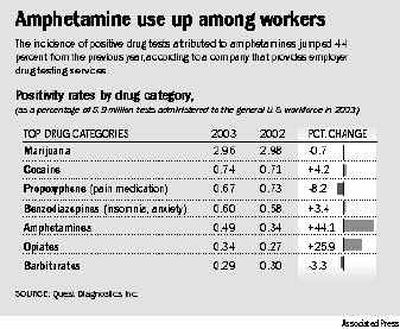More workers using meth, drug tests show

NEW YORK — Often made on the cheap in simple home-based labs, methamphetamine is fast finding its way into the workplace, a new report indicates.
Employers who screen job applicants and workers for drugs saw the number testing positive for methamphetamine surge 68 percent last year, according to Quest Diagnostics Inc., the country’s largest testing company, and usage is likely to continue increasing as the potent stimulant spreads to the eastern United States.
The report — tallying the results of more than 7 million workplace drug tests performed last year by Teterboro, N.J.-based Quest — shows the methamphetamine positive rate jumped, along with a smaller rise in positives for opiates like heroin, even as the overall number of workers failing tests stayed nearly unchanged at 4.5 percent.
“These increases that we’re seeing are the largest increases of any drug or drug class for as long as we’ve been tracking the individual categories” of drug tests, said Barry Sample, director of science and technology for Quest’s workplace drug testing business.
Quest has been conducting its annual survey since 1988, but it has only broken it down by drug category and type of worker since 1997.
The surge in the use of amphetamines, a crystalline stimulant often called “meth” or “ice,” has prompted some states to try to limit sales of the decongestant pseudoephedrine commonly used to make it. While big labs, most in California, continue to supply most of the illegal methamphetamine consumed in the United States, much of the growth has been fed by small, home labs.
Last year, the Drug Enforcement Administration shut down 10,061 small meth labs, up from 8,063 in 2002. “Clearly it’s emerged and is still emerging as a serious problem,” said Ed Childress, a DEA spokesman.
The number of workers and job candidates testing positive for methamphetamine remains small compared to marijuana, by far the biggest reason that people fail employer drug screenings, the Quest figures show. About 3 of every 1,000 workers now test positive for meth, compared to about 3 of every 100 workers testing positive for marijuana.
But while marijuana positives have stayed stable, amphetamine detection is soaring in the general work force. That contrasts with airline pilots, workers in nuclear plants and others whose tests are required by the government, for whom positive meth rates have increased only slightly.
In the general work force, though, usage appears to be rising at an even faster rate than in the past few years, when annual increases in the number of positive drug tests ranged from 14 to 17 percent.
Employers who do screenings saw a 44 percent increase in positives for amphetamines, the category of drugs that includes methamphetamines. Amphetamines now account for about 9.3 percent of all positive tests, more than double the rate in 1999.
Methamphetamine production and usage has its roots in southern California and was long most prevalent in western states. But DEA statistics and Quest testing data shows it has spread to the middle and eastern portions of the country.
Quest found the number of workers testing positive for the drug has increased sharply in southeastern states like Georgia and Alabama. Of the small labs broken up by the DEA last year, the largest number were in Missouri, with states like Tennessee and Arkansas also hotbeds of production.
In addition to the rise in meth usage, Quest found that positive tests for opiates — including both heroin and the painkiller morphine, which is contained in many prescription drugs — are also rising, up 25 percent in 2003 for the general work force.
Overall, the share of workers testing positive for all types of drugs remained nearly unchanged — rising to 4.5 percent from 4.4 percent. That is much lower than the 11 to almost 14 percent rate in the late 1980s, when employer drug tests were not as common. The number of workers testing positive has fluctuated below 5 percent for the last six years.
Marijuana accounted for the largest share of the positive tests, with 2.96 percent of all workers testing positive for the drug. Cocaine was the next leading cause of positive tests, with 0.74 percent of workers testing positive, Quest figures showed. Both results varied little from 2002.